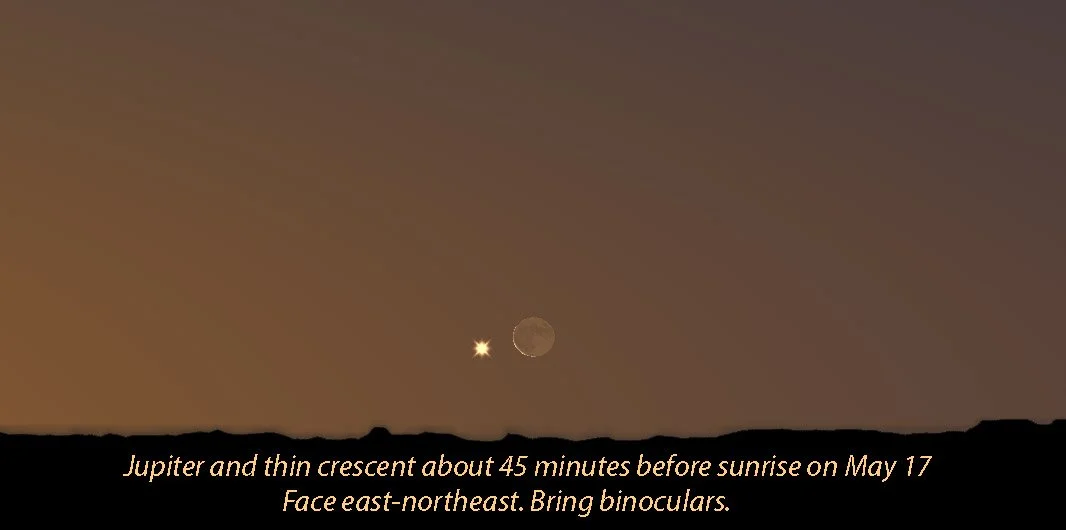May 2023 Night Sky Calendar
What a captivating sight Venus is in the western sky at dusk! The planet sets quite late – right around midnight from many locations – and displays phases like the moon’s when viewed through a small telescope. On May 1 Venus looks like a small gibbous or two-thirds-full moon. By month’s end it dwindles to half and grows larger as its distance from Earth shrinks. If you keep a close eye you’ll notice that the planet slowly gains on much fainter Mars, which crosses from Gemini into Cancer during May.
Saturn appears at dawn but remains rather low in the southeastern sky for the moment. The moon helps pinpoint it on May 13. Jupiter pops back into view in the dawn sky this month. I encourage you to catch its close conjunction with the thin, waning moon on May 17.
One of my favorite spring sky sights is the return of the summer Milky Way, that misty sash of billions of stars so distant they blend into a foggy haze. On May 1, it mounts the eastern sky around 1 a.m. local time. By month’s end – the same time the mosquitos return (grr!) – the puffy band stands over the horizon two hours earlier around 11 p.m. Is summer already so close? The stars say so.
Events:
May 4 – Waxing gibbous moon shines just 2° to the upper left (northeast) of Virgo’s brightest star Spica
May 5 – Full Flower Moon
May 6 (early a.m.) – Peak of the annual Eta Aquariid meteor shower. Shower meteors are bits and pieces of Halley’s Comet that strike the atmosphere at high speed, burn up and produce streaks of light called meteors. Unfortunately, the moon will be full, making viewing it a challenge. But if you like early morning adventures, plan to be out in the last hour before dawn around 3:30-4 a.m. and face south. Northern hemisphere sky watchers might see up to a couple dozen meteors per hour under better circumstances.
May 8-10 – Venus passes 1.5° to 2° above the star cluster M35 in Gemini the Twins on all three evenings. This is a binocular event visible starting in late twilight. Place Venus in the upper part of the binocular field of view and look a short distance below it to spot a little clump of stars. The cluster twinkles from 2,800 light-years away.
May 12 – Last quarter moon
May 12-30 – The International Space Station makes evening and morning passes from dusk till dawn over the next 2 1/2 weeks. The flying space laboratory looks like a brilliant, pale yellow star traveling from west to east across the sky. For local times, go to Heavens Above or NASA's Spot the Station.
May 13 (dawn) – Thick, waning crescent moon passes about 5° to the lower right (southwest) of Saturn in early morning twilight. Look low in the southeastern sky for the pair.
May 17 (dawn) – Wire-thin crescent moon hovers just a degree to the right of Jupiter very low above the eastern horizon about 45 minutes before sunrise. You’ll need an unobstructed view to the east to see the cool duo.
May 19 – New moon
May 22 and 23 – Lunar crescent shines about 5° to the lower right of Venus at dusk on May 22 and 6° to its upper left on May 23.
May 24 – Waxing crescent moon shines about 4° to the upper left of Mars at nightfall
May 26 – Almost-first quarter moon beams 3.5° above Leo’s brightest star Regulus at nightfall
May 27 – First quarter moon
Bob King is an amateur astronomer, author, and passionate educator. He served as a photographer and photo editor at the Duluth News Tribune for 39 years and taught at the UMD planetarium. Bob’s work had a great impact on Voyageurs National Park. To achieve International Dark Sky Park certification, the park was required to host dark sky education events. Through the Night Sky Explorer webinars, the Conservancy was able to fulfill this component and help secure the certification for Voyageurs National Park. We can’t thank Bob King enough for sharing his talents and knowledge with the Conservancy community to support dark sky preservation.





